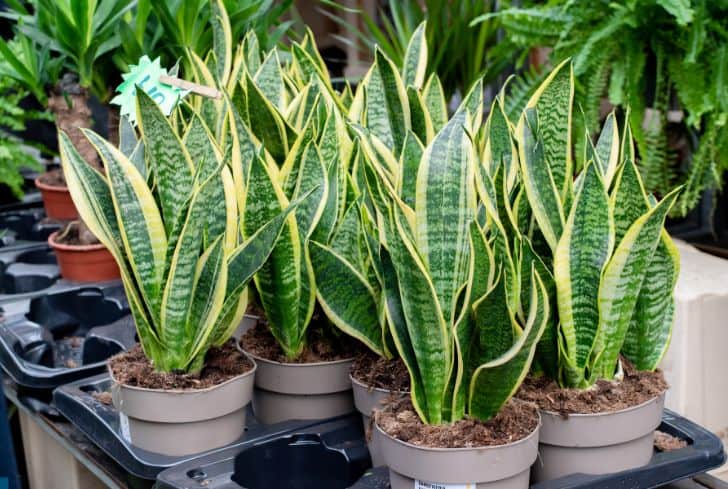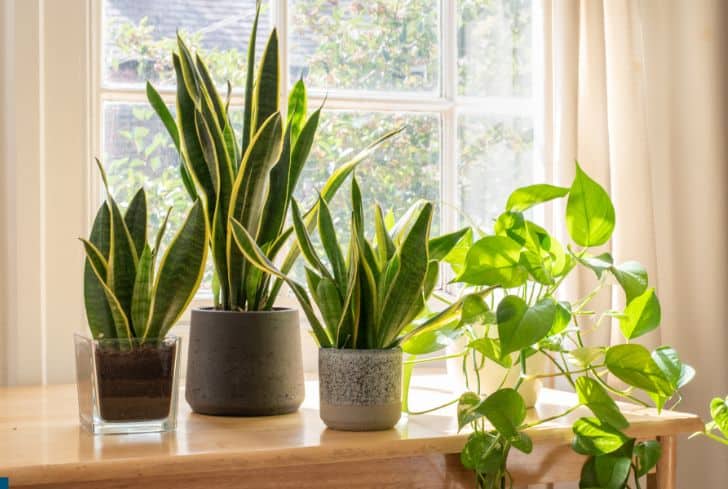The snake plant or commonly also called the mother-in-law’s tongue plant is a tough and easy-going plant that needs little maintenance. A common confusion that a lot of new gardeners might face is – Is Snake plant a succulent or a cactus?
Some common names for the Snake plant include Sansevieria, mother-in-law’s tongue, and Dracaena trifasciata. In this article, you will learn all about the care requirements of this gorgeous plant and whether it is a succulent or a cactus.
Are Snake Plants Succulents or Cactus?
The Snake plant is considered a succulent plant and not a cactus due to its features leaning more towards succulents. Its leaves are thick and fleshy which help in storing water. A feature that distinguishes snake plants from cactus is that cactus has spines and thorns while snake plants have long, plain and fleshy leaves with no thorns.
There are about 50 plant families that fall under the category of succulents, cacti being one of them. So you can say that all cacti are considered succulents but vice versa is not true. Another factor that differentiates succulents from cacti is the presence of areoles.
Areoles are bumps found on cacti from which spines, flowers, and hair grow. These cushiony bumps are not present on all succulents but only on cacti.
What is a Succulent Plant?
A succulent plant is any plant that has thick and fleshy leaves that retain water and help the plant survive in dry and hot climatic conditions. The main feature of a succulent is that its leaves, branches, and stems hold water in them to help the plant sustain in dryer months of the year.
Succulent plants thrive in sandy soils of arid regions of Asia, Africa and South America. Their hardy leaves and stems with water storage capacity enable them to survive droughts. There are many species of succulents in varying colors and sizes but one thing all have in common is their fleshy leaves.
How to Take Care of the Snake Plant?
If you are looking for a plant that is low maintenance and pretty, grow Dracaena trifasciata. Let us take a look at the care requirements of these hardy yet gorgeous plants.
Water
Snake plants are drought-resistant and can easily go without water for up to six weeks. Too much water or wet feet can affect this plant significantly by causing root rot. Avoid overwatering, especially if you live in a tropical area.
Make sure that each time you water your succulent, almost one-third of the soil is dry. Maintain a regular watering schedule to keep your plant healthy. Watering frequency will vary according to the weather and soil conditions in your area.
Light
Snake plants are quite hardy and can survive in any light conditions from low light to direct sunlight. However, they grow best in bright, indirect light. They can tolerate direct sunlight too but prolonged exposure to harsh sunlight, especially in summers can cause leaf burns and browning of leaf edges.
Soil
Snake plants need a loose and airy soil mix to grow well. Do not plant them in compact and clayey soils as their roots suffocate and are prone to rot. You can use the succulent and cacti soil mixes available in most nurseries or online stores.
To prepare the soil mix at home, use equal parts of garden soil, sand, perlite, and peat moss. Instead of peat moss, you can also use coco coir. We recommend using coco coir or peat moss if you live in a dry area as it retains soil moisture for longer periods minimizing the need to water frequently.

Temperature
Temperatures between 60 and 80 degrees Fahrenheit work well for snake plant growth. It can tolerate 10 degrees up and down these extremes but very hot or very cold temperatures can cause slowed-down growth.
Sansevierias are particularly sensitive to cold temperatures. So if you are growing your plant outdoors and temperatures happen to drop below 50 degrees Fahrenheit, bring it indoors to a bright, warm spot.
Humidity
You do not have to worry at all about this plant when it comes to humidity. Most average households have humidity levels between 30 and 60 percent which seems to work perfectly for Snake plants. You do not need to invest in a humidifier to grow this plant.
If you notice yellowing and browning of the leaf edges, plant wilting and drooping and leaves becoming crispy, it could be a sign of very low humidity. Do not worry; the plant can handle stress to a great level and it would not die. You can keep your plant grouped with other plants to regulate temperatures and humidity and it will be back to normal soon.
If you live in a tropical area, humidity levels are generally higher. But that too is not a problem for this succulent. Your plant will be happy and would not face stress such as brown leaf edges due to dry weather conditions.
Fertilizer
Snake plants have minimal fertilizer needs. They can survive with little to no fertilizer too but for robust and healthy growth, you should feed it twice a year with an all-purpose fertilizer in the spring and summer months. Dilute the fertilizer to about half the recommended strength mentioned on the label.
Do not fertilize the plant in winters as it is in a dormant stage showing little growth. Feeding at this stage can cause root burn due to excessive salt deposits in the soil. Wait until spring arrives to resume regular fertilizing.
Repotting Snake Plants
Choose a pot that is about two inches bigger than the previous one and make sure it has drainage holes at the bottom. Adequate drainage allows excess water to drain out and prevents soggy soil conditions.
Prepare a well-draining soil mix keeping in mind that this plant is succulent. You can use the readily available cacti and succulent mixes from nurseries or prepare your own by mixing potting soil, perlite, sand and compost.
After removing the plant from the old soil, place it in the new soil. But make sure you do not bury the plant too deep into the soil while repotting.
Where Should You Place a Snake Plant in Your House?
You can place snake plants anywhere in the house where they can receive indirect light during the day. Bright corners and spots in the house that receive lots of filtered sunlight during the day work well for the snake plant’s growth. Any east or west-facing window is fine.
You can keep it in dimly lit corners but the growth will slow down as compared to a well-lit space. One tip to remember while placing the plant in your home is to not move it around from a low-light spot to direct sunlight too frequently. The sudden change in the lighting can confuse the plant and it can go into shock.
How Do You Know When Your Snake Plant Needs Water?
Snake plants are extremely forgiving when it comes to watering, making them perfect for all beginner gardeners out there. But sometimes, you might notice the leaves wrinkling, falling, drooping or curling. All these along with brown leaf tips could be signs of underwatering.
Signs of overwatering include soft, mushy, droopy and yellow leaves. The leaves become heavy and start to fall over due to excessive water stored in them. You might also notice soil becoming smelly and damp. Keep the signs of underwatering and overwatering in mind and treat the plant as soon as you spot an issue.
The correct way to determine whether your snake plant needs to be watered or not is by doing the finger-knuckle test. Insert one of your fingers till the second knuckle in the soil. If it feels dry and non-sticky, water the plant. Otherwise, hold back and check again after a day or two.
How Much Should a Snake Plant Cost?
The exact prices of Snake plants would depend on their variety, condition, and the seller. On average, most healthy snake plants are available in nurseries for $10 to $50 according to their variety, size and health. It is not the most expensive plant in the market and you might also avail some steal deals in some stores.
For some of the rare and hybrid varieties such as Sansevieria ‘Golden hahnii’ and Sansevieria ‘patens’, you might have to shell out a bit more than usual. Do your research before buying the plant and buy the one that best suits your needs
Conclusion
Snake plants are a must-have for all beginners and expert gardeners alike. If you are looking for a plant that needs minimum care in terms of watering, temperature, soil, and feeding, look no further and get a Snake plant in your home.
For corners, grow the varieties with longer leaves while for desks and smaller spaces, you can choose to grow dwarf varieties. Now that you know all about this succulent plant, it is time you get one of these beauties to your home garden!






